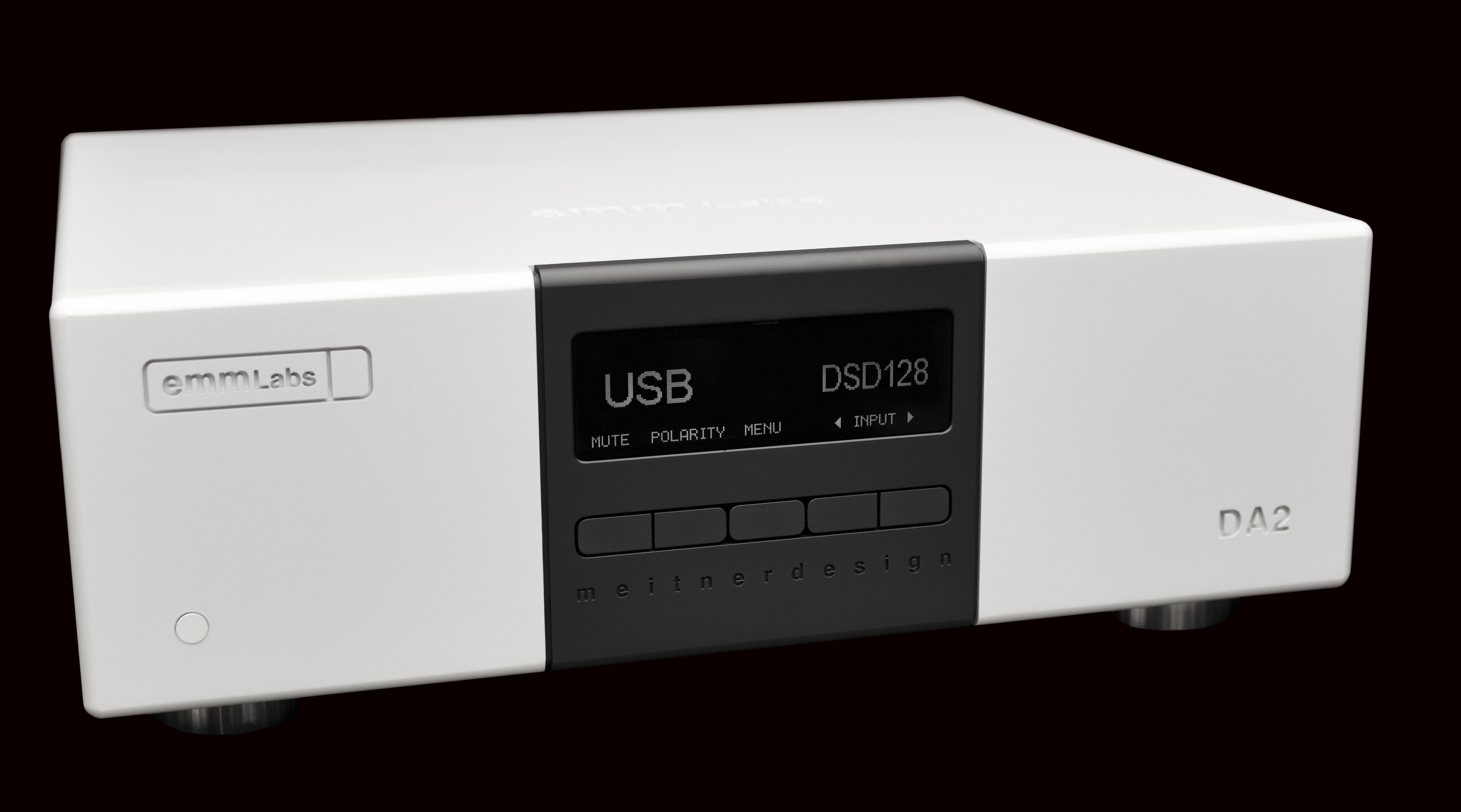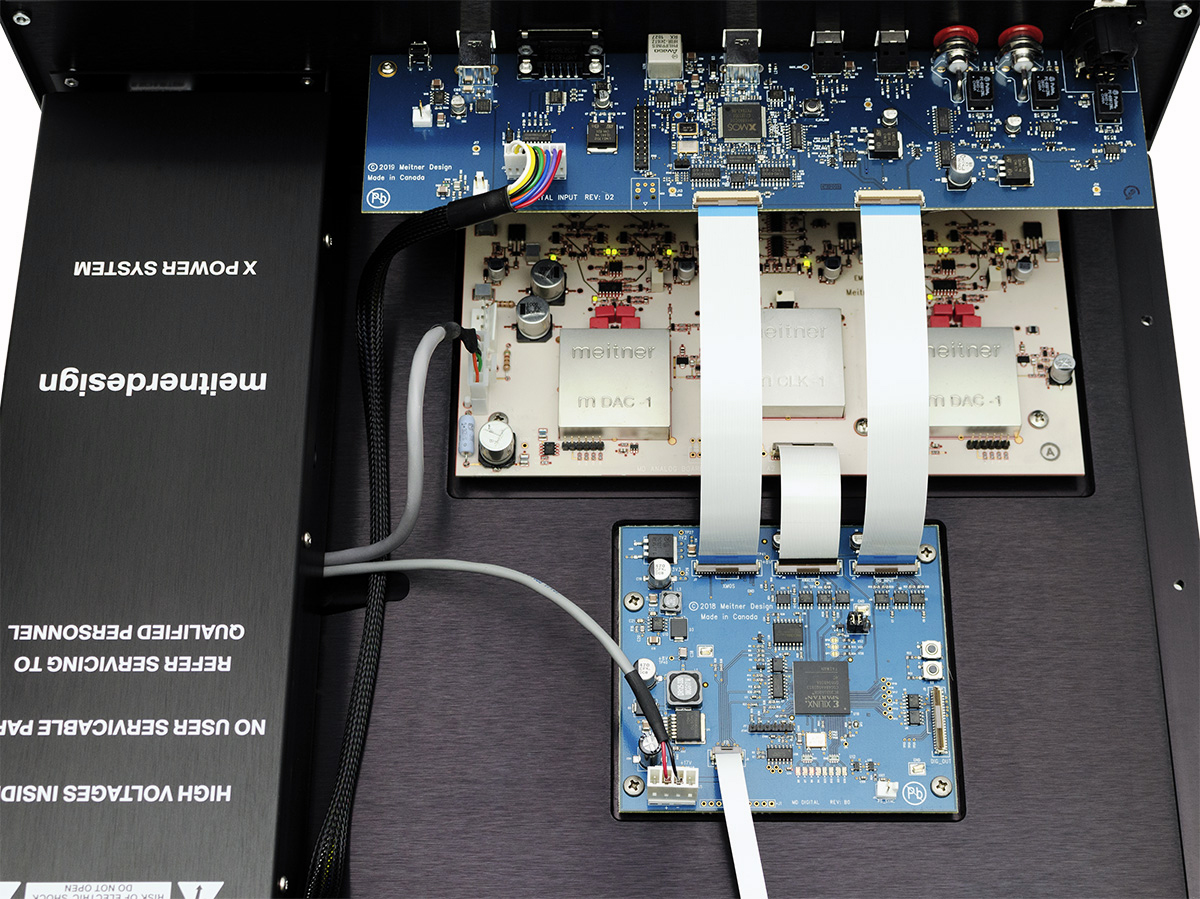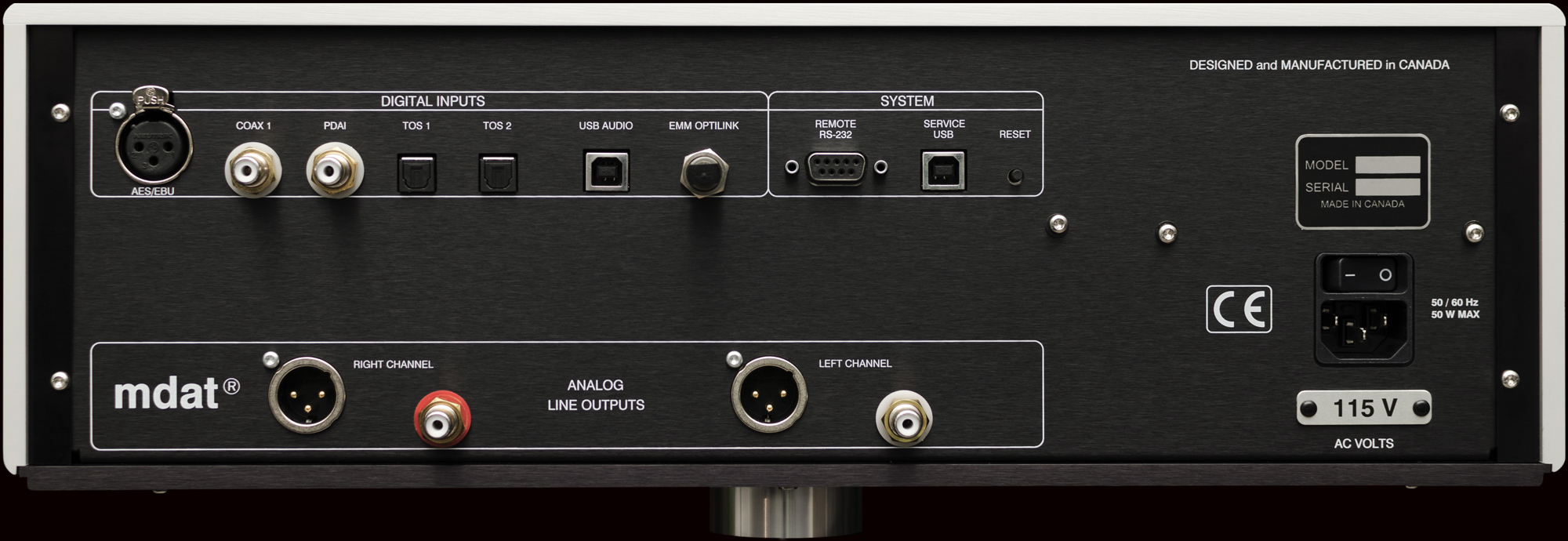Introduction
If you are like me and have been in this hobby for an extended period, you have encountered manufacturers who for whatever reason seem to update their equipment frequently. Inevitably, your existing piece of equipment 1) cannot be updated and 2) has suffered a significant loss to its resale value. This seems particularly true of digital equipment. EMM Labs, headed by Ed Meitner, is not one of those manufacturers. While Meitner does make changes, they are infrequent, are often software based and provided free of charge, and if the change involves hardware, they are retrofittable in the field at a reasonable price. An example of this is his XDS1 SACD player, which has undergone both free firmware updates and, more recently after ten years on the market, an update to the circuitry, which was made available to owners of existing units for about twenty percent of the cost of a new unit. As it turns out, the circuit changes were sonically significant and more than justified the cost. All of this is a lead in to the current article, which chronicles the upgrade of my five-year-old EMM DA2 digital to analog converter.
Technical Details
The EMM Labs DA2 V2 DAC and the V2 firmware upgrade for the flagship converter is a large performance upgrade incorporating significant hardware and firmware changes. Literally all major hardware systems in the DA2 are replaced as part of this upgrade. The main update is EMM’s revised DAC and analog systems. The updates include their design of EMM’s discrete 16xDSD DACs as well as a new analog output stage. These upgrades bring greater transparency, a deeper soundstage and increased dynamics to the DA2’s performance. The new analog stage incorporates the optimized HIGH/LOW gain system, which is switchable in software. This new feature allows users to choose an output level that better fits their system.
Following all the hardware changes, the audio signal processing in the MDAT2 DSP has been enhanced in the digital domain. Along with these improvements and refinements, EMM has also added functional upgrades, including MQA support, NS1 Streamer integration, and the newly implemented software selectable gain system.
DA2 V2 MSRP is $30,000 USD. V2 upgrade for existing DA2s is $5,000 USD.
Listening Impressions
Of late, I have spent a fair bit of time listening to Bruckner’s Symphony No. 4 conducted by Andris Nelsons leading the Gewandhausorchestre (DGG 4797577) (Red Book). This is Bruckner at his considerable best played by a great orchestra led by an excellent conductor. The stage is large with extremely stable image placement, although sometimes the strings push out to the left. Depth is good, low level detail is excellent and tonality is spot-on. There are fewer digital artifacts than I would have expected, although it is not quite analog. The sound is clearly more open than before the DA2 update and less compressed. The top is very extended without being bright. It sorts out loud spots well and the deep bass is extended. As will become more obvious as we move farther into the listening notes, the DA2 accurately recreates what is on the disc.
Next up was Cluytens and the Orchestre de la Societe des Concerts du Conservatoire playing Debussy’s “Jeux” and “Images pour orchestra” (Erato WPCS-13372) (SHM). This is the best I’ve ever heard the digital version of this performance. Previously it suffered from some digital artifacts. Delicacy is first rate: the tap on the cymbal, the tambourine, the shimmer of the strings, even the space around the percussion are superb. The placement of the instruments even seems superior to the analog. Compared to the analog, there is some edge to the brass and elsewhere. As I listen, I begin to think this will become somewhat fatiguing, which is how I’ve always found this SACD. It is the harder edge that ultimately disappoints.
Helen Merrill with Clifford Brown, EMARCY (Esoteric SACD, ESSQ 90147). This is very different from the Analogue Productions LP—it almost sounds as if different masters were used. This is the most listenable I’ve heard this master (which may be the same used for the Japanese LP). Very clean and clear, but some annoying sibilants on the voice (as on the LP). Also, there is some lack of fullness to the voice though it is pretty listenable. Brown’s trumpet has a digital edge on the solos, but I like the clarity of the piano, bass and drums (and sometimes guitar). Yet, when I hear Brown, my ears flinch…as they do with all other versions except the Analogue Productions vinyl, which is reference quality.
Traincha, Metropole Orchestra, “The Look of Love” from Burt Bacharach Songbook, Blue Note – EMI. This is terrific sounding and it’s just a redbook CD. Why? The big band is spread very wide. There is much less edge on the instruments than I often hear and great clarity, which pays, given the variety of instruments and the complexity of portions of the arrangements (very Bacharach-like: harp, electric piano, acoustic piano, all variety of winds and brass, strings, extra voices, guitars). One of the widest soundstages I recall. Voice is very well centered, but could be richer and warmer and more analog-like, I think. But this is one of the best digital listening experiences I can recall.
Cyril Scott Piano Works, Vision, Vlino Gvetadze piano, CC72819 (Challenge). This sounds very nice on almost any system. The piano sound is very rich in this mostly atmospheric, Debussy-influenced music. Bass is rich and deep. There is some cloudiness in the mid-range, which may just be the pedal, but no excessive bite to the high range. Contrast between loud and soft where it happens is excellent, especially between hands (relative quiet in right hand while left cuts loose with a separate idea; for example, see fourth cut).
Harmonia Mundi, Debussy, Les TroisSonates, “The Late Works” HMM 902305. Starting with track 4-5 solo piano: track 4 is soft and fugitive, the top is soft-edged; I feel like I’m actually missing some edge, the same with track 5, but overall reasonably effective nonetheless. The sonata for viola, flute and harp is not missing any air and is very delicate. Original instruments are used. The viola is very throaty, with quicksilver bowing. You can hear the stroke of the fingers on the strings of the harp. Instrumental placement is not quite pinpoint, but that is the recording, and placement is generally clear. Again, as with piano, there is no hint of excessive edge.
Magnetic Skyline by Corinne West and Kelly Joe Phelps, Tin Angel Records, TAR019. The updated EMM DA2 surprised me on this redbook CD, which I had used for some listening comparisons a few months ago. What I’m hearing now is warmer. The guitars still shimmer but have noticeably richer and fuller sounding bodies. Acoustic guitars can sound quite good on many types of systems. We find aural excitement hearing the pick brush across the strings to create a chord, or to coax out a lead line. But that’s just the top of its voice. The sound reverberates inside a beautifully made wooden sound box. It’s so nice to hear both the strings and the wooden sound box where they find their voices. And I feel that I can reach out and touch Corrine West’s lips. There is no veil. I don’t think about whether it’s digital or analog, tube or transistor. It simply sounds like music, as close to “all there” as I’m ever likely to get in my listening room.
Tord Gustavsen Trio, The Other Side, ECM. I’m going to listen to this CD (or the LP, depending on my mood) too much, I fear. But it’s just so damn good; it gives me great confidence that jazz, and, in specific, the piano trio, is as alive as we could ever wish. In this case, the drummer has a really tough job. These are mostly quiet tunes, whether ballads or not, and he has to find something to do that is additive, without crowding. One result is that he concentrates on his various cymbals and his snare, hitting each with different kinds of strokes, in different places. The system’s toughest job is to tell us about all the things that are happening in the cymbals’ voices, especially. Sometimes I listen with fascination to the cymbal work almost without noticing the piano and bass.
Here, I hear the detail of the cymbals as well as or better than I ever have. Once again, I forget about the issue of analog versus digital. It’s just those beautiful sounds, especially the underbelly of the larger cymbals when struck in the right way, in which I can get lost. Not to the detriment of the rest, mind you. It’s just that I know these sounds are so hard to get right, and I am again surprised to hear it sound so right from a “mere” redbook CD.
Steely Dan, Gaucho, Mobile Fidelity. I read somewhere that Mobile Fidelity was given 2nd generation masters for this re-issue. I’ve no idea if this is true, but if so, they were terrific 2nd gen masters. In terms of pure organic musical pleasure — including the mysteries of meaning therein in the best cases —this is a terrific musical experience, one that I’ve dipped into with some regularity over many years of listening and evaluating.
The EMM DA2 seems to get as much as can be gotten here. Donald Fagen’s voice is particularly clear and articulate, even in the way he pulls himself somewhat back in the mix, and the harmony/vocal choir segments are blissful. I can hear everything the various guitarists do (so well), and the good old Fender Rhodes. There is no annoying edge to the brass or anything else, for that matter. True, there might not be quite as much air as I would get from my Japanese pressing of the vinyl…but most of us old timers will remember them as tending toward the top. No matter, I’m living happily within the very wide and clean soundstage (not so deep perhaps, but it’s an artificial artifact of a bunch of different tracks layered on top of one another in any event). That this is a very, very satisfying listen is all that really matters at this moment.
Ambrose Akinmusire, The Imagined Savior is Far Easier to Paint, (B00198260 2 INO 2) Blue Note, tracks 3 and 4. Blue Note has released some good redbook CDs of good recordings in recent years and this is one of them. I didn’t really expect to hear much that I hadn’t heard on these tracks even with the improvements to the DA2. So, I was a bit surprised, therefore, to hear some string lines in the quartet in track 3 that I hadn’t noticed before. In “Vartha” (track 4), I heard air around the wonderfully expressive drums that I hadn’t heard before. The DA2 was simply parsing the details of the signal with a new level of accuracy. The more I listen to the DA2, the more I think that I’m hearing bigger bass than usual, in addition to the detail. It’s not monumental, but having a firm bottom end is a very positive thing.
Frank Sinatra, Only the Lonely, Capitol CDP 7484712. Now this is a real pleasure, a 90’s era reissue of one of Sinatra’s 50’s masterpieces, and it sounds really nice! First, Sinatra’s voice is warm and rich. It’s slightly set back, as is Nelson Riddle’s orchestra. The strings don’t pierce my eardrums…indeed, they sound rather rich, if not quite warm. When an alto flute plays on Angel Eyes (track 2), it sounds like an alto flute, or at least like a flute playing at the bottom of its range. Can’t expect too much of a 50’s pop recording (or is it my ears?), but, man, Frank’s voice sounds like a purring cat. Where is my wine, and my candlelight (like back in the good old 90’s)? Seriously, I’m almost more impressed with what the new electronics can make of a quarter of a century-old silver disc…
David Sylvian, Everything and Nothing, Virgin Records 7243 8 50017 2 7. It was just a few days ago that I heard (for the first time) the LP version of the 2 tracks discussed here. I’m somewhat disappointed that track 1 played through the DA2 actually sounds better (to me) on the CD. Only “somewhat” in that this is one of the best sounding CDs I’ve heard, and thus one I use for auditioning on a fairly regular basis. Track 13 seems more competitive between vinyl and silver disc but, particularly with the upgraded DA2, there is simply nothing fatiguing about the digital presentation, and much to be enjoyed. As with Sinatra’s voice discussed above, Sylvian’s voice almost purrs with warmth. The sibilants are easy, soft like the real world. Curiously, Sylvian sampled Jan Hammer’s Fender Rhodes from the first Mahavishnu Orchestra LP for some of the keyboard “commentary” on this long and ambitious cut. It sneaks in and out like a thief in the night —you would never know. (And never know why, either.) Kenny Wheeler’s flugelhorn comes across with the soft edge of a real flugelhorn, not a flabby trumpet. Really good stuff.
Scriabin, Symphony 3 and Symphony 4, Oslo Philharmonic, Petrenko, LAWQ, LWC 1088. This label is new to me but so far, I like how they record orchestral music. Their perspective is back from the stage, though not quite middle hall. The string sound never grates nor do we hear much bow to speak of. The instruments are spread across the stage in a realistic fashion, without excessive spotlighting —indeed, with no obvious spotlighting at all. All of which is to say that I can turn out the lights and close my eyes and have moments of thinking I am in a real hall listening to a real orchestra.
The Scriabin 4th is the perfectly exotic piece into which to disappear. Richly scored and even richer in harmonies, it is not entirely of this world (much like Scriabin by the time he created it). The upgraded DA2 handles all of this beautifully. It excels in reproducing SACDs, for starters (although it also seems to get more out of redbook than I ever imagined possible). Then it gives us as close to the flavor of the master as I can imagine. From the standpoint of a reviewer, I feel as if I should single out particularly fine-sounding aspects, yet what makes this particular experience work is that the whole sounds pretty darn close to a real orchestra in a real hall. Here, it’s about what the DA2 doesn’t do. It doesn’t give us annoying digital artifacts. It doesn’t have too much or too little of any one thing. It just gives us the experience, and gets out of the way. Yes, I understand that there is really a lot more to it. Yet I dare say Ed Meitner would just as soon have us walk away with this reaction — that we just heard some reproduced music that was particularly terrific because, at a number of moments, it sounded pretty darn close to the real thing.
Final Thoughts
Until very recently, much of my listening has been to vinyl. While I have owned numerous pieces of digital equipment, it wasn’t until the introduction of the EMM Labs DA2 V1 (and its subsequent firmware update) into my system that I first began to believe that maybe digital could someday compete with vinyl, perhaps not eclipse it, but at least compete. Then, five years later along comes the update package that brought my unit up to current production specs. Meitner digital products have always had a natural tonal balance and this remains true of the DA2 V2; however, the upgrade brings greater transparency and increased resolution, particularly with respect to low level information. So much more can be heard from previously muddled lyrics and unearthed low-level effects/ambient detail in the music. There is an increase in the perceived size of the musical space. While lateral image width is improved, it is the increase in depth that is most impressive. (In the past this was not a strong suite of the Meitner.) Bass is also much improved. Note that it is not so much that there is a greater quantity of bass (although at times that can certainly be the case), but more so that the definition is much improved. This is particularly noticeable on drums, which are now much easier to differentiate. Then there is the way that the DA2 V2 handles transients, such as the tap of the drum stick on cymbals.
In conclusion, if you already own anything but the latest version of the EMM DA2, seriously consider having it updated at the factory to current specs. If you have never seriously auditioned a DA2, or if that was a while back, do yourself a favor and give the DA2 another listen.
Copy editor: Dan Rubin
- (Page 1 of 1)




